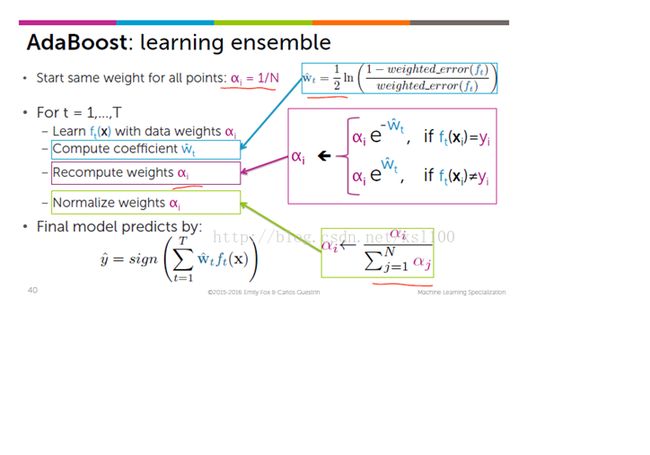知识总结: decision Tree, Bagging, Random Forest, Boosting
本文引用大量网上文章内容,因为时间久远,无法一一列出出处,本文目的纯粹知识总结.如对文章内容有异议,请联系作者本人.
1. Decision Tree
定义就省略了,有ID3 ,CART, C4.5 等变种, 算法大同小异,主要区别的是:
· the splitting criterion (i.e., how "variance" iscalculated)
· whether it builds models for regression (continuous variables, e.g., a score)as well as classification (discrete variables, e.g., a class label)
· technique to eliminate/reduce over-fitting
· whether it can handle incomplete data
几个主要的变种:
· ID3, orIternative Dichotomizer, was the first of three Decision Tree implementationsdeveloped by Ross Quinlan (Quinlan, J. R. 1986. Induction of Decision Trees.Mach. Learn. 1, 1 (Mar. 1986), 81-106.)
· CART, or ClassificationAnd Regression Trees isoften used as a generic acronym for the term Decision Tree, though itapparently has a more specific meaning. In sum, the CART implementation is verysimilar to C4.5; the one notable difference is that CART constructs the treebased on a numerical splitting criterion recursively applied to the data,whereas C4.5 includes the intermediate step of constructing *rule set*s.
· C4.5,Quinlan's next iteration. The new features (versus ID3) are: (i) accepts bothcontinuous and discrete features; (ii) handles incomplete data points; (iii)solves over-fitting problem by (very clever) bottom-up technique usually knownas "pruning"; and (iv) different weights can be applied the featuresthat comprise the training data. Of these, the first three are very important--and i wouldsuggest that any DT implementation you choose have all three. The fourth(differential weighting) is much less important
Tree 的 剪枝是个有趣的题目,在很多的培训中经常提到。有这么几种:
1. limit tree depth,
Stop splitting after a certain depth.
2. classification error,
Do not consider any split that does not cause a sufficient decrease in classification error.
3. Minimun node size.
Do not split an intermediate node which contains too few data points.
2. Bagging
是一种ensemble learning method
Bagging的策略:
- 从样本集中用Bootstrap采样选出n个样本
- 在所有属性上,对这n个样本建立分类器(CART or SVM or ...)
- 重复以上两步m次,i.e.build m个分类器(CART or SVM or ...)
- 将数据放在这m个分类器上跑,最后vote看到底分到哪一类
Fit many large trees to bootstrap resampled versions of the training data, and classify by majority vote.
3. Random forest(Breiman1999):
- 从样本集中用Bootstrap采样选出n个样本,预建立CART
- 在树的每个节点上,从所有属性中随机选择k个属性,选择出一个最佳分割属性作为节点 (这个是比Bagging 的最大不同)
- 重复以上两步m次,i.e.build m棵CART
- 这m个CART形成Random Forest
4. Boosting(Freund & Schapire 1996):
Fit many large or small trees to reweighted versions of the training data. Classify by weighted majority vote.
首先给个大致的概念,boosting在选择hyperspace的时候给样本加了一个权值,使得loss function尽量考虑那些分错类的样本(i.e.分错类的样本weight大)。
怎么做的呢?
- boosting重采样的不是样本,而是样本的分布,对于分类正确的样本权值低,分类错误的样本权值高(通常是边界附近的样本),最后的分类器是很多弱分类器的线性叠加(加权组合),分类器相当简单。
